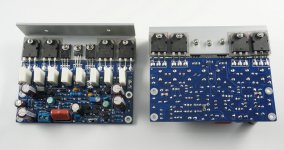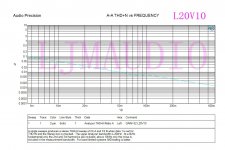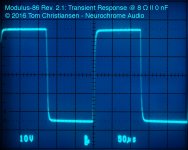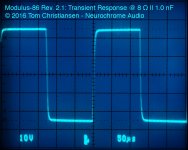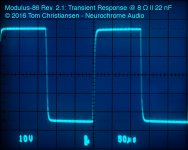What do these most recent posts have to do with Tom's Modulus-86 amp?
Or TIM for that matter. TIM and it's cousin SID were related to the slewing of the internal stages of the amplifier. If you make sure the various stages don't hit the slew rate limit at audio frequencies, you won't have TIM. That's pretty easy to do with modern tools and devices, actually. As we concluded last this issue surfaced, it's a product of the 1970ies and it was solved shortly thereafter.
Tom
Or TIM for that matter. TIM and it's cousin SID were related to the slewing of the internal stages of the amplifier. If you make sure the various stages don't hit the slew rate limit at audio frequencies, you won't have TIM. That's pretty easy to do with modern tools and devices, actually. As we concluded last this issue surfaced, it's a product of the 1970ies and it was solved shortly thereafter.
Indeed. It is a non-issue these days (at least with reasonably competent designs).
What load?This is my LME49810 power amplifier.
After my test, 40 w THD + N = 0.002%.
Looks pretty good - but I thought you were talking about TIM (SID).
A bit busy working now. Take time to do this.
In fact I'm rather keen on these data is not very great.
L20 AMP VER10. 200 w 8r + -65V
It has the strong ability of driving.
50W THD+N =0.0015%。
Etc. Have time I will measure. I also have many LM3886. But I don't like to use them.
L20 might be L series in larger distortion.
But it has a strong effect.
In comparison, L12-2 THD + N = 0.0005%.
But I prefer L20 very much.
Attachments
Last edited:
A bit busy working now. Take time to do this.
In fact I'm rather keen on these data is not very great.
L20 AMP VER10. 200 w 8r + -65V
It has the strong ability of driving.
50W THD+N =0.0015%。
Etc. Have time I will measure. I also have many LM3886. But I don't like to use them.
Again, what does this have to do with TIM, or the Modulus-86 amp?
What load?
May I suggest that you take your questions about JLM_JLM's amp to his thread on the topic, please? Here's the link to his thread: http://www.diyaudio.com/forums/chip-amps/290900-ljm-lme49810-ic-amp.html
Thanks,
Tom
A bit busy working now. Take time to do this.
When you have the data available, would you kindly post them to your own thread? I'm sure you have your own followers, so they will be expecting to see your data on your thread rather than on this one.
Highjacking threads is generally frowned upon - as you can deduce from the previous comments.
Thanks,
Tom
So on the topic of the Modulus-86 Rev. 2.1: As mentioned previously, the edge rate of my function generator was overdriving the input of the Modulus-86, causing the amplifier to reach its slew rate limitation way too soon. That's not surprising given the 10 ns rise time of the function generator.
The fastest slew rate that can be generated by a DAC running at 192 kHz is 1.07 V/us, so I retook the transient response plots at this slew rate. As expected, this cleaned up the edges considerably.
The little blip of ringing that you see on the 8 Ω || 1 uF load is actually the resonance of the Thiele inductor and the load capacitance.
Tom
The fastest slew rate that can be generated by a DAC running at 192 kHz is 1.07 V/us, so I retook the transient response plots at this slew rate. As expected, this cleaned up the edges considerably.
The little blip of ringing that you see on the 8 Ω || 1 uF load is actually the resonance of the Thiele inductor and the load capacitance.
Tom
Attachments
-
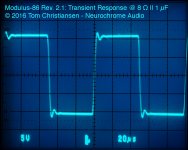 MOD86_R2p1_Trans10V_8R1uF.jpg151.4 KB · Views: 117
MOD86_R2p1_Trans10V_8R1uF.jpg151.4 KB · Views: 117 -
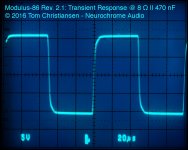 MOD86_R2p1_Trans10V_8R470nF.jpg153.2 KB · Views: 107
MOD86_R2p1_Trans10V_8R470nF.jpg153.2 KB · Views: 107 -
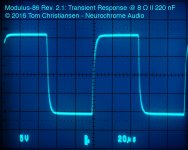 MOD86_R2p1_Trans10V_8R220nF.jpg153.3 KB · Views: 111
MOD86_R2p1_Trans10V_8R220nF.jpg153.3 KB · Views: 111 -
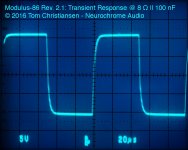 MOD86_R2p1_Trans10V_8R100nF.jpg152.4 KB · Views: 105
MOD86_R2p1_Trans10V_8R100nF.jpg152.4 KB · Views: 105 -
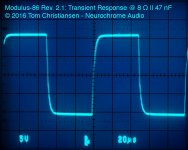 MOD86_R2p1_Trans10V_8R47nF.jpg150 KB · Views: 114
MOD86_R2p1_Trans10V_8R47nF.jpg150 KB · Views: 114 -
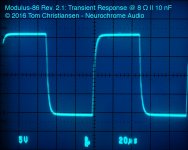 MOD86_R2p1_Trans10V_8R10nF.jpg146 KB · Views: 107
MOD86_R2p1_Trans10V_8R10nF.jpg146 KB · Views: 107 -
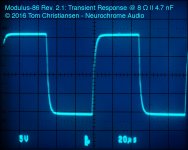 MOD86_R2p1_Trans10V_8R4n7F.jpg144.9 KB · Views: 113
MOD86_R2p1_Trans10V_8R4n7F.jpg144.9 KB · Views: 113 -
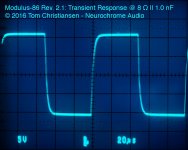 MOD86_R2p1_Trans10V_8R1n0F.jpg142.6 KB · Views: 500
MOD86_R2p1_Trans10V_8R1n0F.jpg142.6 KB · Views: 500 -
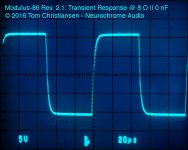 MOD86_R2p1_Trans10V_8R0nF.jpg145.8 KB · Views: 507
MOD86_R2p1_Trans10V_8R0nF.jpg145.8 KB · Views: 507
Increasing the output voltage to just below clipping produces the following responses.
I was using an arbitrary waveform generator to control the edge rate of the square wave. The observant reader will notice that I changed the frequency slightly in this second set of plots. This was done to maintain the constant 1.07 V/us edge rate. It was easier to change the frequency than to reprogram the ARB.
Tom
I was using an arbitrary waveform generator to control the edge rate of the square wave. The observant reader will notice that I changed the frequency slightly in this second set of plots. This was done to maintain the constant 1.07 V/us edge rate. It was easier to change the frequency than to reprogram the ARB.
Tom
Attachments
Much better, Tom, and more realistic. I do notice the slightest unhappiness on the 470nF load -- the roundish corner at the top when going up and bottom when going down is not quite as roundish as the loads with less C.
Very commendable performance.
Very commendable performance.
Much better, Tom, and more realistic. I do notice the slightest unhappiness on the 470nF load -- the roundish corner at the top when going up and bottom when going down is not quite as roundish as the loads with less C.
That is true. At 470 nF the last 20 % of the edge gets a little faster as the Thiele inductor + load cap resonance is starting to wake up.
Very commendable performance.
Thank you. I'm quite pleased with it.
Tom
Hi Tom, do you plan to make a smaller PCB (CMS version) as a rev 2.2?
65$ is for one bare PCB, right?
Thanks
65$ is for one bare PCB, right?
Thanks
As of this time, I am not planning to have an SMD (surface mount devices) version of the Modulus-86. I am platting an all-SMD stereo Modulus-86 board. This board will be around the same price as two Modulus-86 boards.
A single Modulus-86 board will give you one channel of amplification. The cost of the board is $65/each for the bare board. They're available for purchase through my website: Neurochrome Audio: High performance DIY audio circuits.
Tom
A single Modulus-86 board will give you one channel of amplification. The cost of the board is $65/each for the bare board. They're available for purchase through my website: Neurochrome Audio: High performance DIY audio circuits.
Tom
That should be, "planning an all-SMD stereo board". Man. My fingers just can't type sometimes.
Tom
Tom
I think I actually initially intended to type plotting but changed my mind and wanted planning instead. My fingers lagged behind my brain there. 🙂 Of course with auto-correct, it is turned into a word that's spelled correctly but means something entirely different. I had no idea platting was a word. It means to subdivide a plat. A plat being a to-scale drawing of a chunk of land. Ha! Who knew?!
The stereo board will likely be available towards the end of August. If I have the board available before then, I'll bring a handful to the DIY Audio Fest on Vancouver Island in the middle of August.
Tom
The stereo board will likely be available towards the end of August. If I have the board available before then, I'll bring a handful to the DIY Audio Fest on Vancouver Island in the middle of August.
Tom
The stereo board will likely be available towards the end of August. If I have the board available before then, I'll bring a handful to the DIY Audio Fest on Vancouver Island in the middle of August.
Tom
Hi Tom,
will the upcoming SMD-stereo board also deliver the same kind of performance (THD, etc) as the non-SMD single-channel Modulus-86? Does switching so SMD have any effect on that?
Also, is the Parallel86 gone? I really like to the see a more powerful version of the Modulus-86 (100-200W per channel 8 Ohms), especially for LFE/subwoofer use...
thanks
roland
will the upcoming SMD-stereo board also deliver the same kind of performance (THD, etc) as the non-SMD single-channel Modulus-86? Does switching so SMD have any effect on that?
I fully expect the SMD Stereo MOD86 to have the same performance as the mono leaded Modulus-86.
Switching to SMD does present a challenge if you want good performance. A significant amount of development time was dedicated to component selection and performance verification of the various sensitive blocks of the circuit. I will ensure that the SMD components won't be the limiting factor on the performance.
Also, is the Parallel86 gone?
Yes. TI has discontinued the LM4780. Newark/Farnell now sits on all the world-wide distributor stock and they have about 1000 of them left. To get them shipped to anywhere outside of the UK involves a $20 freight charge per order. I supported the circuit as long as I could, but with the chips gone I can't justify investing more energy in that project. I need to invest my time in projects that will keep me going long-term. I'll keep providing support for those who bought boards, obviously.
I am willing to entertain the thought of a group buy, though. If there is enough interest, I will make one last, final, ultimate (yes! really!) board order. You can indicate your interest here: http://www.diyaudio.com/forums/group-buys/293914-neurochrome-parallel-86-group-buy.html#post4767811
I really like to the see a more powerful version of the Modulus-86 (100-200W per channel 8 Ohms), especially for LFE/subwoofer use...
A Parallel-86 won't get you to 100 W into 8 Ω, so you're looking for another solution. I'm working on an amp design for a friend that'll get you into the 100-200 W power range. I'm not making progress as fast as I'd like, but I am making slow and steady progress on the project.
Tom
Last edited:
Nat Semi had an app note for a bridged -parallel 3886 amp that was good for 200w/8 ohms. Performance was adequate. It was called the BPA 200, IIRC.
Perhaps you could lay out boards for that, or even design a composite version with lower distortion?
Perhaps you could lay out boards for that, or even design a composite version with lower distortion?
A Parallel-86 won't get you to 100 W into 8 Ω, so you're looking for another solution. I'm working on an amp design for a friend that'll get you into the 100-200 W power range. I'm not making progress as fast as I'd like, but I am making slow and steady progress on the project.
Tom
- Home
- Vendor's Bazaar
- Modulus-86: Composite amplifier achieving <0.0004 % THD+N.
